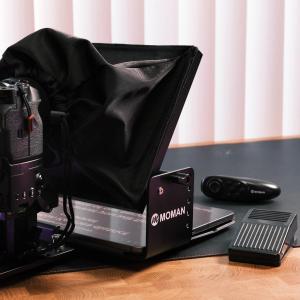Howdy
h1>
How to Master the Teleprompter for Camera The Ultimate Guid
If you want to produce a more professional and assured video, the teleprompter for camera is a lifesaver. Whether you're recording on a DSLR, smartphone, or pro rig, this equipment ensures eye contact, minimizes script mistakes, and enhances delivery on-camera. In this tutorial, we'll discuss the types of teleprompters, their setup, and maximizing every recording session with your camera and teleprompter system.
What is a Camera Teleprompter?
A teleprompter for camera is a reflective tool positioned in front of your lens to display a scrolling script. This enables you to read your lines without having to turn your head, which keeps your delivery natural and professional. As a content creator, teacher, or business person, employing a teleprompter reinforces communication and audience trust. This device is more and more widely used in online content, webinars, video resumes, and interviews. When you make eye contact while speaking smoothly, you establish a more engaging connection with your audience. That's why teleprompters are today ubiquitous in home studios as well as professional production facilities.
Types of Teleprompters: DSLR vs Phone Camera
Selecting the correct type of teleprompter is based on your equipment. A DSLR camera teleprompter is made for bigger, more complex systems. These tend to come with a sturdy base, room for larger lenses, and allowance for professional equipment such as shoulder rigs or tripods. The phone camera teleprompter, on the other hand, is light and transportable. It's suitable for vloggers, solo business owners, and social media influencers posting short-form video content. They tend to be small, clip-on, and easy to install. Both are excellent value, but the choice should be based on your way of shooting, camera type, and target filming location.
Why Do You Need a Teleprompter for a Camera?
Employing a teleprompter for camera can significantly improve your video quality. It is time-saving by doing away with memorizing scripts, minimizing errors and unnecessary retakes. With the right placement of a teleprompter, you keep your viewers engaged through uninterrupted eye contact. Whether recording a course, podcasting, or selling a product, the video camera teleprompter helps you communicate your message professionally and confidently. It also helps multiple takes remain consistent, which is critical in branding and storytelling. In the end, it makes you more ready, more professional, and more polished—regardless of industry or content medium.
How to Use Teleprompter with Camera
It is easy and fun to learn how to use a teleprompter with camera configurations. Begin by attaching the teleprompter via the bracket suitable for your DSLR or phone. Ensure that the beam splitter glass is positioned at a 45° angle in front of the lens. Place a smartphone or tablet below with your script installed on a teleprompter app. Control text size and scroll speed to accommodate your reading speed. Position the camera behind the glass straight for crisp framing. Practice a few times beforehand to sync up your delivery with the scroll. With prep, your delivery will be easy, effortless, and professional.
Selecting the Right Teleprompter Camera Attachment
A sturdy teleprompter camera attachment will provide stability and accuracy. The appropriate attachment secures your device and still allows for alignment between your lens and reflective glass. For DSLRs, seek out universal mounts with extendable arms. If using a smartphone, ensure the teleprompter has a phone clamp or tray with anti-slip padding. Weight and size also come into play—portable models are ideal for mobile content, while studio rigs might appreciate more robust gear. Some attachments even have remote controls or Bluetooth scroll apps, providing hand-free ease. Select on the basis of flexibility, build quality, and camera compatibility.
Correct Teleprompter Camera Position for Best Results
The teleprompter camera position determines how natural and professional your videos will look. Position the teleprompter at eye level to maintain direct eye contact with the audience. Your camera should sit directly behind the beam splitter glass, centered to the script display. Avoid placing the device too high or low, as that can make your gaze appear unnatural. The perfect distance for you and the teleprompter varies with text size—read comfortably far enough away, but close enough for framing in tight. Careful positioning makes your delivery appear confident and maintains the audience's attention on your message.
Conclusion
A camera teleprompter is not only a shooting tool—but a performance booster. Whether you're employing a teleprompter for dslr camera, a phone camera teleprompter, or a mounted camera teleprompter, adding this utility to your production platform can significantly enhance the quality and presentation of content. Learning to use teleprompter with camera, selecting the proper teleprompter camera attachment, and achieving proper teleprompter camera position will all serve to make you speak like a pro. Whether an influencer or corporate trainer, any on-camera speaker will appreciate the power and convenience of this amazing tool.
FAQ
What is a Camera Mounted Teleprompter?
A camera mounted teleprompter mounts on your recording equipment. This mounting keeps your script in front of the lens so that you can read while maintaining natural eye contact. These configurations typically comprise a beam splitter glass, script phone/tablet mount, and adjustable brackets. They work well in interviews, marketing videos, YouTube vlogs, and even live streaming. Camera-mounted types minimize eye shifts that occur when scripts are set off-camera. By putting your lines right in front of you, you engage your audience while enhancing speech delivery, timing, and confidence—even on long shoots or complicated scripts.



